Interaction Effects of Nitrogen Source and Irrigation Regime on Tuber Quality, Yield, and Water Use Efficiency of Solanum tuberosum L.
Abstract
1. Introduction
2. Materials and Methods
2.1. Site, Plant Material and Experimental Design
2.2. Soil Analysis and Climatic Conditions
2.3. Fertilization
2.4. Measurements
2.4.1. Crop-Soil-Water Relations
Reference Crop Evapotranspiration (ETo)
- ETo: reference evapotranspiration (mm day−1),
- Rn: net radiation at the crop surface (MJ m−2 day−1),
- G: soil heat flux density (MJ m−2 day−1),
- T: mean daily air temperature at 2 m height (°C),
- u2: wind speed at 2 m height (m s−1),
- es: saturation vapor pressure (kPa),
- ea: actual vapor pressure (kP),
- es − ea: vapor pressure deficit (kPa),
- Δ: slope of the vapor pressure-temperature curve (kPa °C−1),
- γ: psychrometric constant (kPa °C−1).
Crop Evapotranspiration (ETc)
- ETc: crop evapotranspiration (mm day−1),
- ETo: reference crop evapotranspiration (mm day−1),
- Kc: crop coefficient.
Applied Irrigation Water (AIW)
- AIW: depth of applied irrigation water (mm),
- ETc: crop evapotranspiration (mm day−1),
- I: irrigation interval (days),
- Ea: irrigation application efficiency for the drip irrigation system (≈ 85% at the site),
- LR: leaching requirements: The extra amount of applied water needed for salt leaching, calculated according to FAO [28] as follows:
- ECiw: salinity of irrigation water (dS m−1),
- ECe: average of soil salinity tolerated by the crop, as measured by soil-saturated extract (dS m−1). Under the current experimental conditions, no additional water was added for leaching to avoid any effect on the stress treatments.
Water Consumptive Use (WCU)
- WCU: water consumptive use or crop evapotranspiration (mm),
- i: number of soil layers,
- θ2: soil moisture content after irrigation (% volume basis),
- θ1: soil moisture content immediately before irrigation (% volume basis),
- d: depth of soil layer (mm).
Water Utilization Efficiency (WUtE)
2.4.2. Vegetative Growth, Foliage and Tuber Yields
Chlorophyll Content
Tuber and Foliage Yields
2.4.3. Chemical Quality Analysis of Tubers
2.5. Statistical Analysis
3. Results and Discussion
3.1. Water Consumptive Use (WCU, m3 ha−1)
3.2. Yield of Potato Tubers
3.3. Yield of Fresh and Dry Foliage
3.4. Water Utilization Efficiency (WUtE)
3.5. Quality of Potato Tubers in Terms of Elemental Analysis and Protein
3.5.1. Nitrogen, Sulfur, and Protein Contents in Tubers
Phosphorus Content in Tubers
3.5.2. Potassium Content in Tubers
4. Conclusions
Author Contributions
Funding
Acknowledgments
Conflicts of Interest
References
- FAOSTAT. World Potato Production Quantity (Tonnes), Yields and Harvested Areas for 2017. Available online: http://fenix.fao.org/faostat/internal/en/#data/QC/visualize (accessed on 11 January 2019).
- Rykaczewska, K. The impact of high temperature during growing season on potato cultivars with different response to environmental stresses. Am. J. Plant Sci. 2013, 4, 2386–2393. [Google Scholar] [CrossRef]
- Sriom, S.; Mishra, D.P.; Rajbhar, P.; Singh, D.; Singh, R.K.; Mishra, S.K. Effect of different levels of nitrogen on growth and yield in potato (Solanum Tuberosum L.) Cv. Kufri Khyati. Int. J. Curr. Microbiol. Appl. Sci. 2017, 6, 1456–1460. [Google Scholar]
- Izmirlioglu, G.; Demirci, A. Enhanced bio-ethanol production from industrial potato waste by statistical medium optimization. Int. J. Mol. Sci. 2015, 16, 24490–24505. [Google Scholar] [CrossRef]
- Ekin, Z. Integrated use of humic acid and plant growth promoting rhizobacteria to ensure higher potato productivity in sustainable agriculture. Sustainability 2019, 11, 3417. [Google Scholar] [CrossRef]
- El Mokh, F.; Nagaz, K.; Masmoudi, M.M.; Mechlia, N.B. Yield and water productivity of drip-irrigated potato under different nitrogen levels and irrigation regime with saline water in arid Tunisia. Am. J. Plant Sci. 2015, 6, 501–510. [Google Scholar] [CrossRef]
- Badr, M.A.; Abou Hussein, S.D.; El-Tohamy, W.A.; Gruda, N. Efficiency of subsurface drip irrigation for potato production under different dry stress conditions. Gesunde Pflanz. 2010, 2, 63–70. [Google Scholar] [CrossRef]
- Ierna, A.; Mauromicale, G. Tuber yield and irrigation water productivity in early potatoes as affected by irrigation regime. Agric. Water Manag. 2012, 115, 276–284. [Google Scholar] [CrossRef]
- Wang, F.; Kang, Y.; Liu, S. Effects of drip irrigation frequency on soil wetting pattern and potato growth in North China Plain. Agric. Water Manag. 2006, 79, 248–264. [Google Scholar] [CrossRef]
- Yuan, B.; Nishiyama, S.; Kang, Y. Effects of different irrigation regimes on the growth and yield of drip-irrigated potato. Agric. Water Manag. 2003, 63, 153–167. [Google Scholar] [CrossRef]
- Fabeiro, C.; Olalla, F.M.S.; Juan, J.A. Yield and size of deficit irrigated potatoes. Agric. Water Manag. 2001, 48, 255–266. [Google Scholar] [CrossRef]
- Šrek, P.; Hejcman, M.; Kunzová, E. Multivariate analysis of relationship between potato (Solanum tuberosum L.) yield, amount of applied elements, their concentrations in tubers and uptake in a long-term fertilizer experiment. Field Crop. Res. 2010, 118, 183–193. [Google Scholar] [CrossRef]
- Bélanger, G.; Walsh, J.R.; Richards, J.E.; Milburn, P.H.; Ziadi, N. Nitrogen fertilization and irrigation affects tuber characteristics of two potato cultivars. Am. J. Potato Res. 2002, 79, 269–279. [Google Scholar] [CrossRef]
- Khan, I.; Zaman, M.; Khan, M.J.; Iqbal, M.; Babar, M.N. How to improve yield and quality of potatoes: Effects of two rates of urea N, urease inhibitor and Cytozyme nutritional program. J. Soil Sci. Plant Nutr. 2014, 14, 268–276. [Google Scholar] [CrossRef]
- Ahmed, A.; Abd El-Baky, M.; Ghoname, A.; Riad, G.; El-Abd, S. Potato tuber quality as affected by nitrogen form and rate. Middle East. Russ. J. Plant Sci. Biotechnol. 2009, 3, 47–52. [Google Scholar]
- Khalil, A.A. Growth, yield, quality and nutrient uptake of potato (Solanum tuberosum L.) as affected by two nitrogen sources applied at various ratios. J. Soil Sci. Agric. Eng. 2014, 5, 1067–1076. [Google Scholar] [CrossRef]
- Gao, Y.; Jia, L.; Hu, B.; Alva, A.; Fan, M. Potato stolon and tuber growth influenced by nitrogen form. Plant Prod. Sci. 2014, 17, 138–143. [Google Scholar] [CrossRef]
- Vaezzadeh, M.; Naderidarbaghshahi, M. The effect of various nitrogen fertilizer amounts on yield and nitrate accumulation in tubers of two potato cultivars in cold regions of Isfahan (Iran). Int. J. Agric. Crop. Sci. 2012, 4, 1688–1691. [Google Scholar]
- Abu-Zinada, I.A.I. Potato response to potassium and nitrogen fertilization under Gaza Strip conditions. J. Al Azhar Univ. Gaza Nat. Sci. 2009, 11, 15–30. [Google Scholar]
- Badr, M.A.; El-Tohamy, W.A.; Zaghloul, A.M. Yield and water use efficiency of potato grown under different irrigation and nitrogen levels in an arid region. Agric. Water Manag. 2012, 110, 9–15. [Google Scholar] [CrossRef]
- Alva, A.K.; Moore, A.D.; Collins, H.P. Impact of Deficit Irrigation on Tuber Yield and Quality of Potato Cultivars. J. Crop. Improv. 2012, 26, 211–227. [Google Scholar] [CrossRef]
- Page, A.L.; Miller, R.H.; Keeny, D.R. Methods of Soil Analysis, Part II. In Chemical and Microbiological Properties, 2nd ed.; Monograph No. 9; American Society of Agronomy: Madison, WI, USA, 1982. [Google Scholar]
- Klute, A. Methods of Soil Analysis: Part I. In Physical and Mineralogical Methods, 2nd ed.; Monograph No. 9; American Society of Agronomy: Madison, WI, USA, 1986. [Google Scholar]
- FAO. Crop evapotranspiration: Guidelines for computing crop water requirements. In FAO Irrigation and Drainage Paper; Richard, A., Luis, P., Dirk, R., Martin, S., Eds.; Food and Agricultural Organization: Rome, Italy, 1998; p. 56. [Google Scholar]
- FAO. CROPWAT: A computer program for irrigation planning and management. In FAO Irrigation and Drainage Paper; Martin, S., Ed.; Food and Agricultural Organization: Rome, Italy, 1992; p. 46. [Google Scholar]
- FAO. Guidelines for predicting crop water requirements. In Irrigation and Drainage Paper; Doorenbos, J., Pruitt, W.O., Eds.; Food and Agricultural Organization: Rome, Italy, 1977; p. 24. [Google Scholar]
- Vermeiren, L.; Jopling, G.A. Localized irrigation: Design, installation, operation, evaluation. In FAO Irrigation and Drainage Paper; Food and Agricultural Organization: Rome, Italy, 1984; p. 36. [Google Scholar]
- FAO. Water quality for agriculture. In FAO Irrigation and Drainage Paper; Food and Agricultural Organization: Rome, Italy, 1985; p. 29. [Google Scholar]
- Dasberg, S.; Dalton, F.N. Time domain reflectometry measurements of water content and electrical conductivity of layered soil columns. Soil Sci. Soc. Am. J. 1985, 49, 293–297. [Google Scholar] [CrossRef]
- Israelsen, O.W.; Hansen, V.E. Irrigation Principles and Practices, 3rd ed.; Wiley International Edition: New York, NY, USA, 1962. [Google Scholar]
- Jensen, M.E. Design and Operation of Farm Irrigation Systems; American Society Agricultural Engineering: St. Joseph, MO, USA, 1983; p. 827. [Google Scholar]
- Meier, U. BBCH-Monograph: Growth Stages of Mono-and Dicotyledonous Plants, 2nd ed.; Federal Biological Research Centre for Agriculture and Forestry: Berlin, Germany, 2001. [Google Scholar]
- Costache, M.A.; Campeanu, G.; Neata, G. Studies concerning the extraction of chlorophyll and total carotenoids from vegetables. Rom. Biotechnol. Lett. 2012, 17, 7702–7708. [Google Scholar]
- Chapman, H.D.; Pratt, P.F. Methods of Analysis for Soils, Plants and Waters, Priced Publication 4034; Division of Agricultural Science, University of California: Berkeley, CA, USA, 1982. [Google Scholar]
- Motsara, M.R.; Roy, R.N. Guide to Laboratory Establishment for Plant Nutrient Analysis; Food and Agriculture Organization of the United Nations: Rome, Italy, 2008; Volume 19. [Google Scholar]
- Ranganna, S. Handbook of Analysis and Quality Control for Fruit and Vegetable Product, 2nd ed.; Tata McGraw-Hill Publishing Company Limited: New Delhi, India, 1977. [Google Scholar]
- Eid, T.A.; Ali, S.E.M.M.; Abou-Baker, N.H. Influence of soil moisture depletion on water requirements yield and mineral. J. Appl. Sci. Res. 2013, 9, 1457–1466. [Google Scholar]
- Hassanpanah, D. Evaluation of potato cultivars for resistance against water deficit stress under in vivo conditions. Potato Res. 2010, 53, 383–392. [Google Scholar] [CrossRef]
- Brady, N.C.; Weil, R.R. The Nature and Properties of Soils, 14th ed.; Pearson Education International Macmillan Publishing Co. Inc.: Upper Saddle River, NJ, USA, 2008; p. 975. [Google Scholar]
- Kahsay, W.S. Effects of nitrogen and phosphorus on potatoes production in Ethiopia: A review. Cogent Food Agric. 2019, 5, 1572985. [Google Scholar] [CrossRef]
- Klikocka, H. Sulfur supply in Polish agriculture. In Sulfur Metabolism in Plants; Sirko, A., De Kok, L.J., Haneklaus, S., Hawkesford, M.J., Rennenberg, H., Saito, K., Schnug, E., Stulen, I., Eds.; Backhuys Publ.: Leiden, The Netherlands; Margraf Publishers: Weikersheim, Germany, 2009; pp. 45–48. [Google Scholar]
- Ladha, J.K.; Pathak, H.; Krupnik, T.J.; Six, J.; van Kessel, C. Efficiency of fertilizer nitrogen in cereal production: Retrospects and prospects. Adv. Agron. 2005, 87, 85–156. [Google Scholar]
- Shrestha, R.; Cooperband, L.; MacGuidwin, A. Strategies to reduce nitrate leaching into groundwater in potato grown in sandy soils: Case study from North Central USA. Am. J. Potato Res. 2010, 87, 229–244. [Google Scholar] [CrossRef]
- Cambouris, A.N.; Luce, M.S.; Zebarth, B.J.; Ziadi, N.; Grant, C.A.; Perron, P. Potato response to nitrogen sources and rates in an irrigated sandy soil. Agron. J. 2016, 108, 391–401. [Google Scholar] [CrossRef]
- Foti, S.; Mauromicale, G.; Ierna, A. Influence of irrigation regimes on growth and yield of potato cv. Spunta. Potato Res. 1995, 38, 307–318. [Google Scholar] [CrossRef]
- Harris, P.M. Water. In The Potato Crop; Harris, P.M., Ed.; Chapman & Hall: London, UK, 1978; pp. 244–277. [Google Scholar]
- Cantore, V.; Wassar, F.; Yamaç, S.S.; Sellami, M.H.; Albrizio, R.; Stellacci, A.M.; Todorovic, M. Yield and water use efficiency of early potato grown under different irrigation regimes. Int. J. Plant Prod. 2014, 8, 409–428. [Google Scholar]
- Marouani, A.; Behi, O.; Ben Ammar, H.; Sahli, A.; Ben Jeddi, F. Effect of various sources of nitrogen fertilizer on yield and tubers nitrogen accumulation of Spunta potato cultivar (Solanum tuberosum L.). J. New Sci. Agric. Biotechnol. 2015, 13, 339–404. [Google Scholar]
- Davis, J.M.; Loescher, W.H.; Hammond, M.W.; Thornton, R.E. Response of Russet Burbank potatoes to soil fumigation and nitrogen fertilizers. Am. Potato J. 1986, 63, 71–79. [Google Scholar] [CrossRef]
- Wang, N.; Xing, Y.; Wang, X. Exploring options for improving potato productivity through reducing crop yield gap in loess plateau of china based on grey correlation analysis. Sustainability 2019, 11, 5621. [Google Scholar] [CrossRef]
- Qiqige, S.; Jia, L.; Qin, Y.; Chen, Y.; Fan, M. Effects of different nitrogen forms on potato growth and development. J. Plant Nutr. 2017, 40, 1651–1659. [Google Scholar] [CrossRef]
- Weixing, C.; Tibbitts, T.W. Study of various NH4+/NO3- mixtures for enhancing growth of potatoes. J. Plant. Nutr. 1993, 16, 1691–1704. [Google Scholar]
- Farrag, K.; Abdrabbo, M.A.A.; Hegab, S.A.M. Growth and productivity of potato under different irrigation levels and mulch types in the North West of the Nile Delta, Egypt. Middle East J. Appl. Sci. 2016, 6, 774–786. [Google Scholar]
- Onder, S.; Caliskan, M.E.; Onder, D.; Caliskan, S. Different irrigation methods and water stress effects on potato yield and yield components. Agric. Water Manag. 2005, 73, 73–86. [Google Scholar] [CrossRef]
- Amzallag, G.N.; Herner, H.R.; Poljakott-Mayber, A. Interaction between mineral nutrients, cytokinin and giberellic acid during growth of sorghum at high nacl salinity. J. Exp. Bot. 1992, 43, 81–87. [Google Scholar] [CrossRef]
- Ritchie, J.T. Atmospheric and soil water influences on the plant water balance. Agric. Meteorol. 1974, 14, 183–198. [Google Scholar] [CrossRef]
- Gültekin, R.; Ertek, A. Effects of deficit irrigation on the potato tuber development and quality. Int. J. Agric. Environ. Food Sci. 2018, 2, 93–102. [Google Scholar] [CrossRef][Green Version]
- Naumann, M.; Koch, M.; Thiel, H.; Gransee, A.; Pawelzik, E. The importance of nutrient management for potato production part II: Plant nutrition and tuber quality. In Potato Research; Springer: Dordrecht, The Netherlands, 2019; pp. 1–17. [Google Scholar]
- Sahota, T.S. Importance of sulphur in crop production. Northwest Sci. 2006, 9, 10–12. [Google Scholar]
- Barczak, B. Sulphur as a Nutrient Determining the Yield Size and Quality of Selected Crop Species; Monograph 144; UTP Bydgoszcz: Bydgoszcz, Poland, 2010; p. 131. [Google Scholar]
- Klikocka, H.; Haneklaus, S.; Bloem, E.; Schnug, E. The evaluation of potato sulphur fertilization demands. Fertil Fertil 2003, 4, 143–150. [Google Scholar]
- Leonel, M.; Carmo, E.L.; Fernandes, A.M.; Franco, C.M.; Soratto, R.P. Physico-chemical properties of starches isolated from potato cultivars grown in soils with different phosphorus availability. J. Sci. Food Agric. 2016, 96, 1900–1905. [Google Scholar] [CrossRef] [PubMed]
- Leonel, M.; do Carmo, E.L.; Fernandes, A.M.; Soratto, R.P.; Ebúrneo, J.A.M.; Garcia, É.L.; dos Santos, T.P.R. Chemical composition of potato tubers: The effect of cultivars and growth conditions. J. Food Sci. Technol. 2017, 54, 2372–2378. [Google Scholar] [CrossRef]
- Winkelmann, H. Potassium fertiliser application to potatoes. Kartoffelbau 1992, 43, 412–418. [Google Scholar]
- Darwish, T.; Atallah, T.; Hajhasan, S.; Chranek, A. Management of nitrogen by fertigation of potato in Lebanon. Nutr. Cycl. Agroecosyst. 2003, 67, 1–11. [Google Scholar] [CrossRef]
- Saoud, A.A.; Van Cleemput, O.; Hofman, G. Uptake and balance of labelled fertilizer nitrogen by potatoes. Fertil. Res. 1992, 31, 351–353. [Google Scholar] [CrossRef]
- Tein, B.; Kauer, K.; Eremeev, V.; Luik, A.; Selge, A.; Loit, E. Farming systems affect potato (Solanum tuberosum L.) tuber and soil quality. Field Crop. Res. 2014, 156, 1–11. [Google Scholar] [CrossRef]
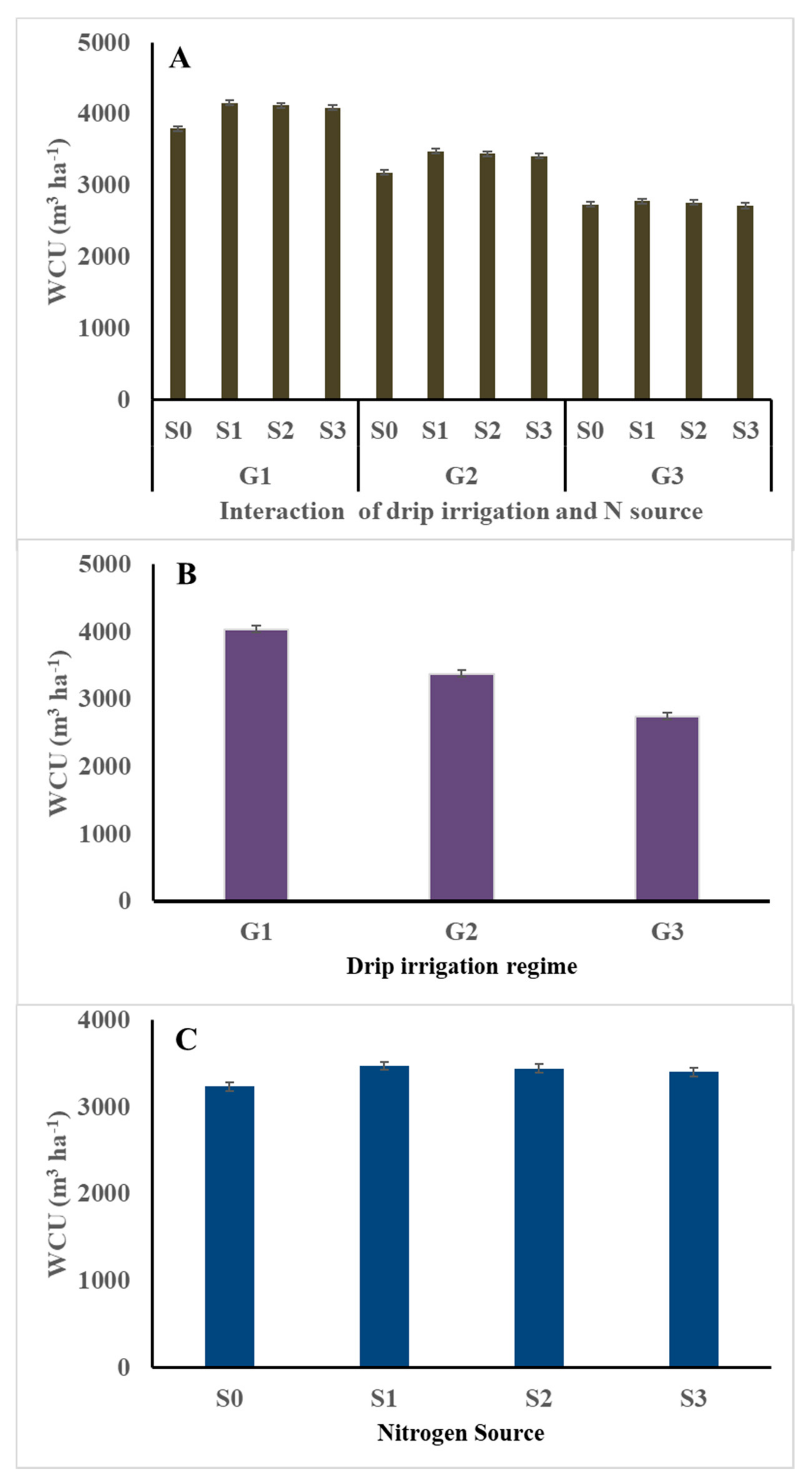
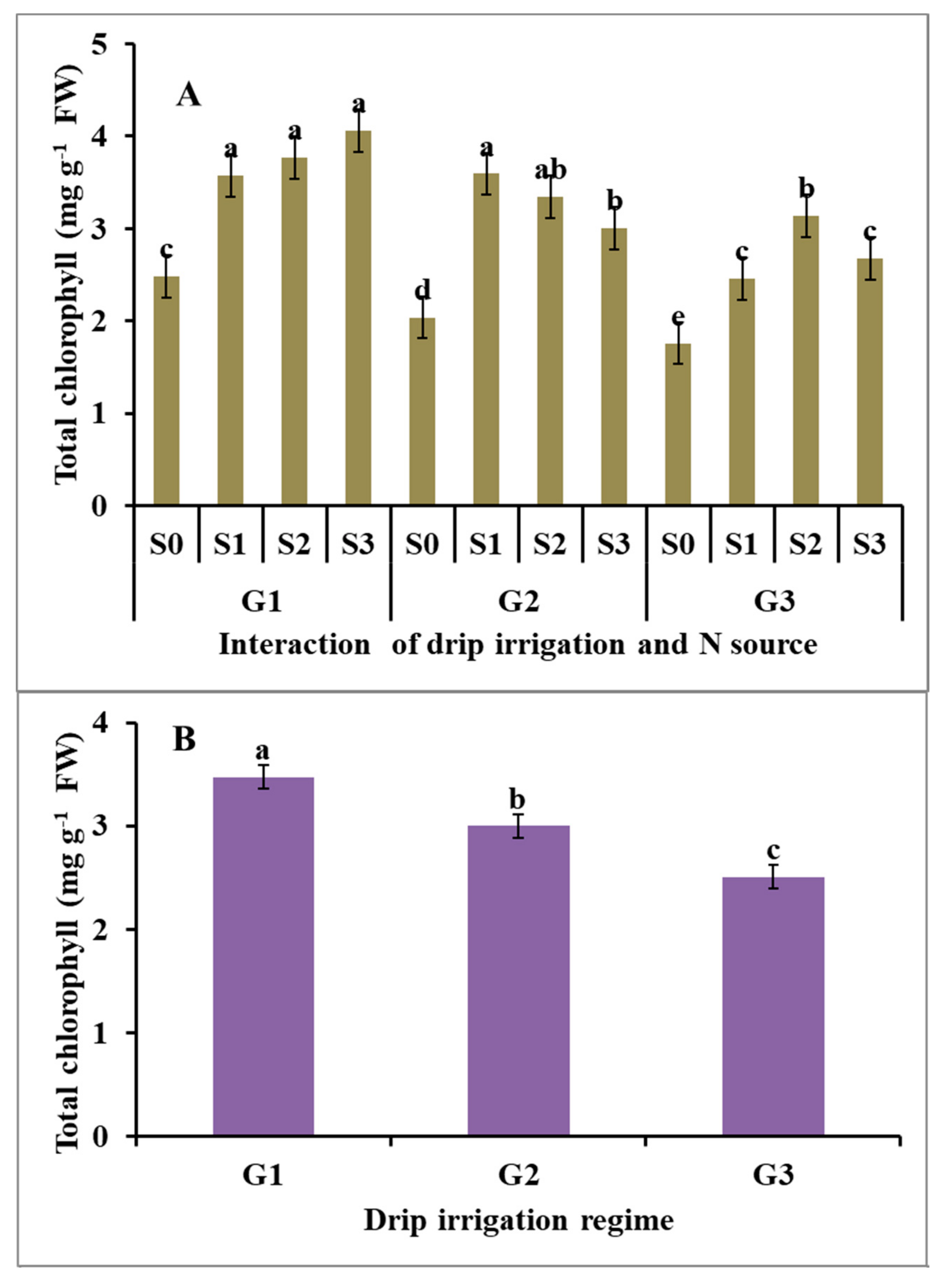
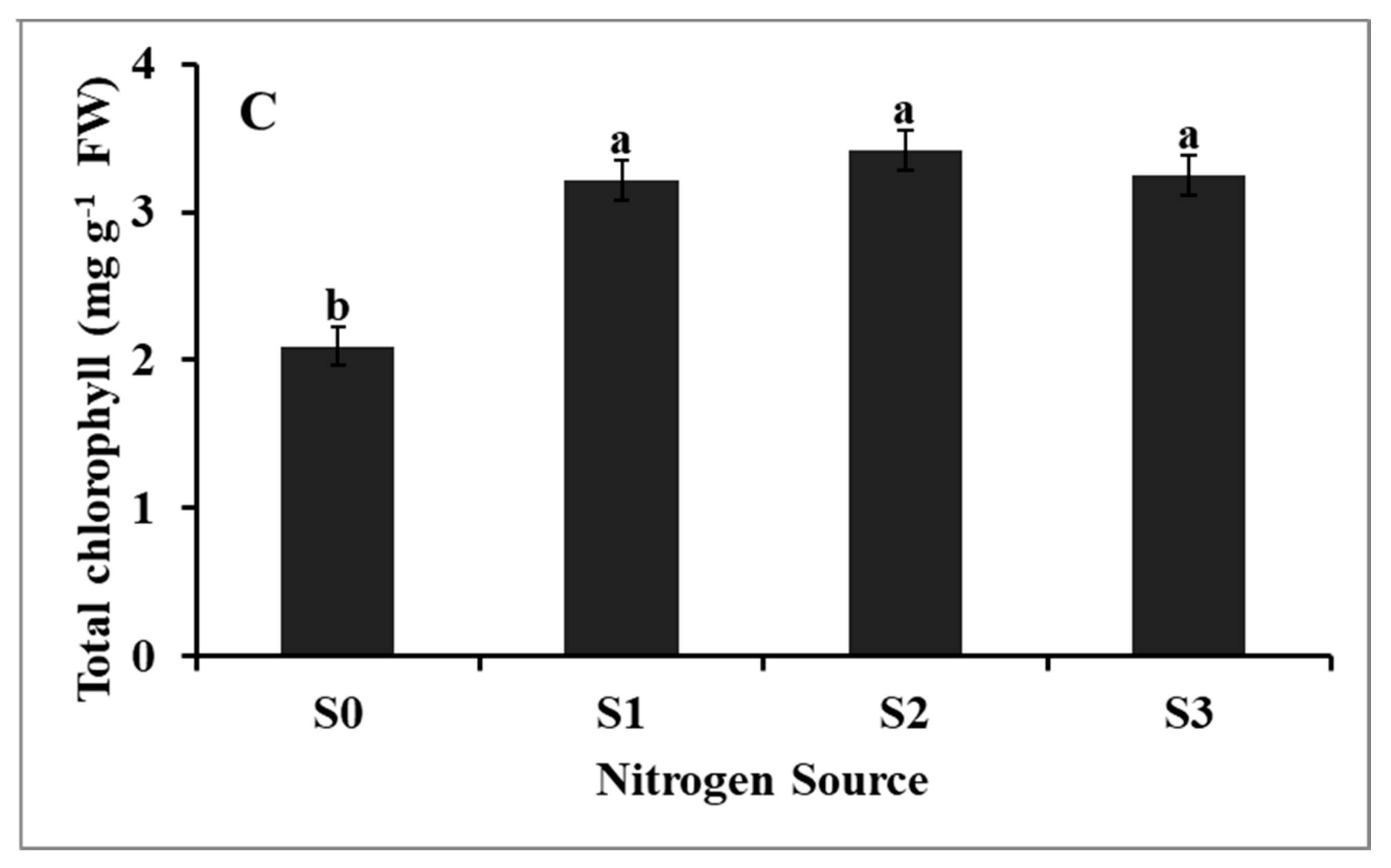
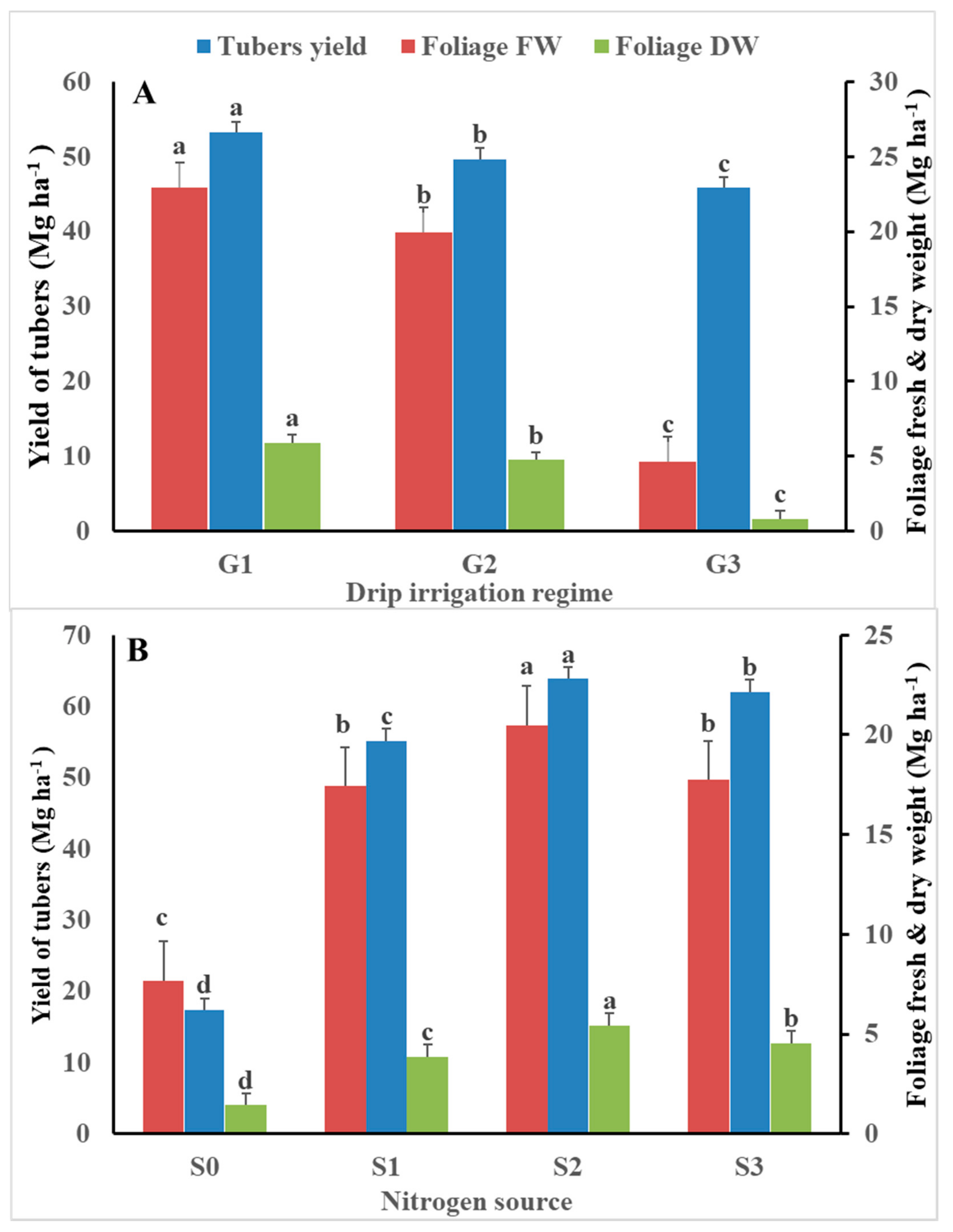
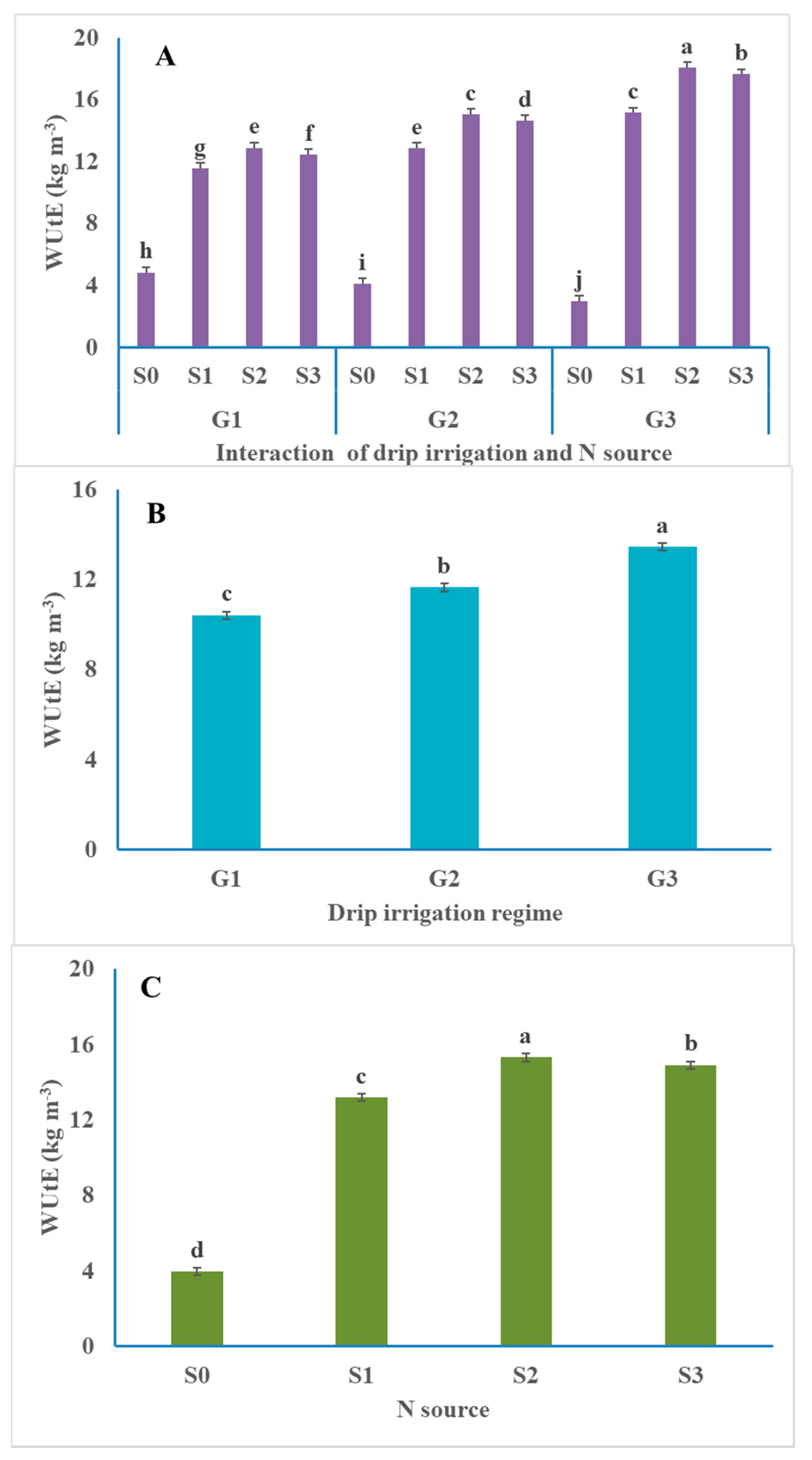
| Depth (cm) | Field Capacity (FC) | Wilting Point (WP) | Available Water (AW) | Bulk Density (Bd), Mg m−3 | |||
|---|---|---|---|---|---|---|---|
| % | cm | % | cm | % | cm | ||
| 0–15 | 35.8 | 6.50 | 18.8 | 3.41 | 17.0 | 3.10 | 1.21 |
| 15–30 | 33.4 | 5.91 | 17.3 | 3.10 | 16.1 | 2.81 | 1.18 |
| 30–45 | 31.9 | 5.98 | 15.1 | 2.83 | 16.8 | 3.15 | 1.25 |
| 45–60 | 31.7 | 7.23 | 16.8 | 3.83 | 14.9 | 3.4 | 1.52 |
| Parameter | Value |
|---|---|
| CaCO3− (gkg−1) | 42.90 |
| Organic matter (g kg−1) | 20.50 |
| Total N (mg kg−1) | 210.00 |
| Available N (mg kg−1) | 51.00 |
| Available K (mg kg−1) | 400.00 |
| Available P (mg kg−1) | 22.30 |
| pH (1:2.5 w/v soil: water suspension) | 7.49 |
| EC dS m−1 (paste extract) | 2.44 |
| Saturation % | 53.00 |
| Cations and anions in soil paste extract (m molc L−1) | |
| Na+ | 3.57 |
| K+ | 0.97 |
| Ca2+ | 17.05 |
| Mg2+ | 2.86 |
| CO32− | 0.00 |
| HCO3− | 5.42 |
| Cl− | 9.32 |
| SO42− | 9.71 |
| Clay (%) | 36.39 |
| Silt (%) | 22.88 |
| Fine sand (%) | 36.40 |
| Coarse sand (%) | 4.33 |
| Texture (International Texture Classification) | Light Clay |
| Month | Temperature (°C) | WS (ms−1) | RH (%) | SD (h) | Precipitation (mm Month−1) | Kc | ETo (mm Month−1) | |
|---|---|---|---|---|---|---|---|---|
| (Max.) | (Min.) | |||||||
| October | 31.7 | 18.3 | 3.7 | 55 | 11.2 | 17.5 | 0.50 | 5.87 |
| November | 26.5 | 14.2 | 3.6 | 57 | 10.4 | 25.2 | 0.78 | 4.45 |
| December | 20.8 | 10.4 | 4.1 | 64 | 10.1 | 24.7 | 1.11 | 3.32 |
| January | 17.9 | 7.8 | 3.9 | 64 | 10.3 | 10.2 | 0.67 | 2.48 |
| Mean | 24.2 | 12.6 | 3.8 | 60.0 | 10.5 | 19.4 | 0.76 | 4.03 |
| Month | Irrigation Treatment | ||
|---|---|---|---|
| G1 | G2 | G3 | |
| m3 Month−1 | m3 Month−1 | m3 Month−1 | |
| October | 988 | 823 | 659 |
| November | 1661 | 1384 | 1107 |
| December | 1773 | 1477 | 1182 |
| January | 697 | 581 | 464 |
| Total (m3 season−1) | 5119 | 4265 | 3412 |
| Irrigation Regime (G) | N Source (S) | Yield of Tubers (Mg ha−1) | Foliage Fresh Weigh (Mg ha−1) | Foliage Dry Weigh (Mg ha−1) |
|---|---|---|---|---|
| G1 | S0 | 24.64 e | 11.82 c | 2.68 d |
| S1 | 59.04 b | 25.10ab | 5.49 c | |
| S2 | 65.79 a | 28.88 a | 8.28 a | |
| S3 | 63.60 a | 25.91 a | 7.13 b | |
| G2 | S0 | 17.42 f | 7.71 d | 1.23 e |
| S1 | 54.79 c | 22.49 ab | 5.20 c | |
| S2 | 64.11 a | 27.07 a | 6.91 b | |
| S3 | 62.40 ab | 22.43 b | 5.67 c | |
| G3 | S0 | 10.15 g | 3.52 e | 0.40 e |
| S1 | 51.64 d | 4.69 d | 0.89 e | |
| S2 | 61.57 ab | 5.48 d | 1.13 e | |
| S3 | 60.11 b | 4.84 d | 0.87 e |
| Irrigation Regime (G) | N source (S) | Nitrogen (g kg−1) | Phosphorus (g kg−1) | Potassium (g kg−1) | Sulfur (g kg−1) | Protein (g kg−1) |
|---|---|---|---|---|---|---|
| G1 | S0 | 4.24 c | 2.10 ab | 28.04 b | 0.04 d | 26.50 c |
| S1 | 6.63 b | 2.76 a | 32.29 a | 1.01 c | 41.44 b | |
| S2 | 8.55 ab | 2.50 a | 32.78 a | 1.19 b | 53.44 ab | |
| S3 | 7.95 b | 2.38 ab | 24.76 bc | 1.28 b | 49.69 b | |
| G2 | S0 | 3.39 c | 1.97 b | 24.46 c | 1.04 c | 21.19 c |
| S1 | 9.60 ab | 2.21 ab | 25.22 bc | 1.10 bc | 60.00 ab | |
| S2 | 10.25 a | 2.52 a | 22.93 c | 1.27 b | 64.06 a | |
| S3 | 9.80 ab | 2.28 ab | 24.29 c | 1.41 a | 61.25 ab | |
| G3 | S0 | 2.75 c | 2.60 d | 16.87 d | 1.14 bc | 17.19 c |
| S1 | 9.03 ab | 2.42 ab | 25.66 bc | 1.25 b | 56.44 ab | |
| S2 | 10.83 a | 2.55 a | 26.65 b | 1.33 ab | 67.69 a | |
| S3 | 11.37 a | 2.50 a | 26.29 b | 1.49 a | 71.06 a |
| Parameters | Nitrogen (g kg−1) | Phosphorus (g kg−1) | Potassium (g kg−1) | Sulfur (g kg−1) | Protein (g kg−1) | |
|---|---|---|---|---|---|---|
| Treatments | ||||||
| Irrigation regime (G) | ||||||
| G1 | 6.84 b | 2.44 a | 29.47 a | 0.87 c | 42.75 b | |
| G2 | 8.26 a | 2.25 b | 24.23 b | 1.20 b | 51.63 a | |
| G3 | 8.50 a | 2.52 a | 23.87 c | 1.30 a | 53.13 a | |
| N source (S) | ||||||
| S0 | 3.46 c | 2.22 b | 23.12 c | 0.73 d | 21.63 c | |
| S1 | 8.42 b | 2.46 ab | 27.72 a | 1.12 c | 52.63 b | |
| S2 | 9.88 a | 2.52 a | 27.45 a | 1.27 b | 61.75 a | |
| S3 | 9.71 a | 2.39 ab | 25.11 b | 1.40 a | 60.69 a | |
© 2020 by the authors. Licensee MDPI, Basel, Switzerland. This article is an open access article distributed under the terms and conditions of the Creative Commons Attribution (CC BY) license (http://creativecommons.org/licenses/by/4.0/).
Share and Cite
Eid, M.A.M.; Abdel-Salam, A.A.; Salem, H.M.; Mahrous, S.E.; Seleiman, M.F.; Alsadon, A.A.; Solieman, T.H.I.; Ibrahim, A.A. Interaction Effects of Nitrogen Source and Irrigation Regime on Tuber Quality, Yield, and Water Use Efficiency of Solanum tuberosum L. Plants 2020, 9, 110. https://doi.org/10.3390/plants9010110
Eid MAM, Abdel-Salam AA, Salem HM, Mahrous SE, Seleiman MF, Alsadon AA, Solieman THI, Ibrahim AA. Interaction Effects of Nitrogen Source and Irrigation Regime on Tuber Quality, Yield, and Water Use Efficiency of Solanum tuberosum L. Plants. 2020; 9(1):110. https://doi.org/10.3390/plants9010110
Chicago/Turabian StyleEid, Mohamed A. M., Ali A. Abdel-Salam, Haythum M. Salem, Samira E. Mahrous, Mahmoud F. Seleiman, Abdullah A. Alsadon, Talaat H. I. Solieman, and Abdullah A. Ibrahim. 2020. "Interaction Effects of Nitrogen Source and Irrigation Regime on Tuber Quality, Yield, and Water Use Efficiency of Solanum tuberosum L." Plants 9, no. 1: 110. https://doi.org/10.3390/plants9010110
APA StyleEid, M. A. M., Abdel-Salam, A. A., Salem, H. M., Mahrous, S. E., Seleiman, M. F., Alsadon, A. A., Solieman, T. H. I., & Ibrahim, A. A. (2020). Interaction Effects of Nitrogen Source and Irrigation Regime on Tuber Quality, Yield, and Water Use Efficiency of Solanum tuberosum L. Plants, 9(1), 110. https://doi.org/10.3390/plants9010110







